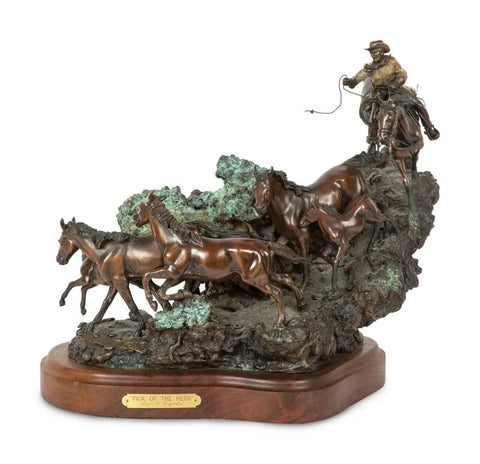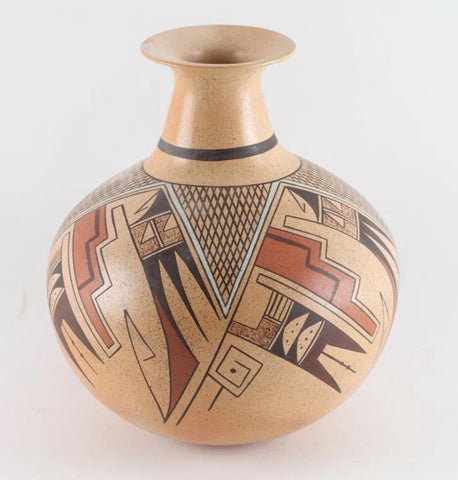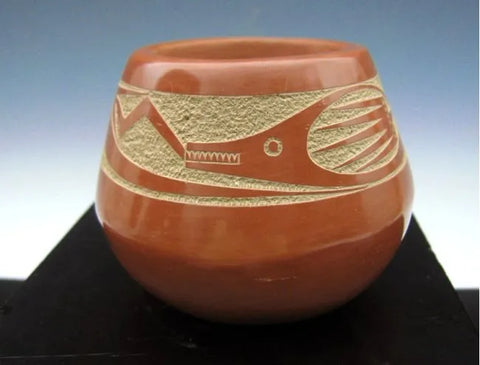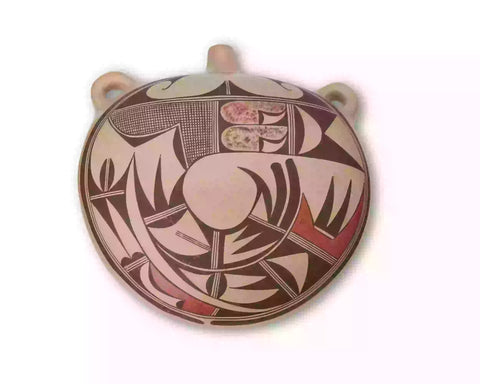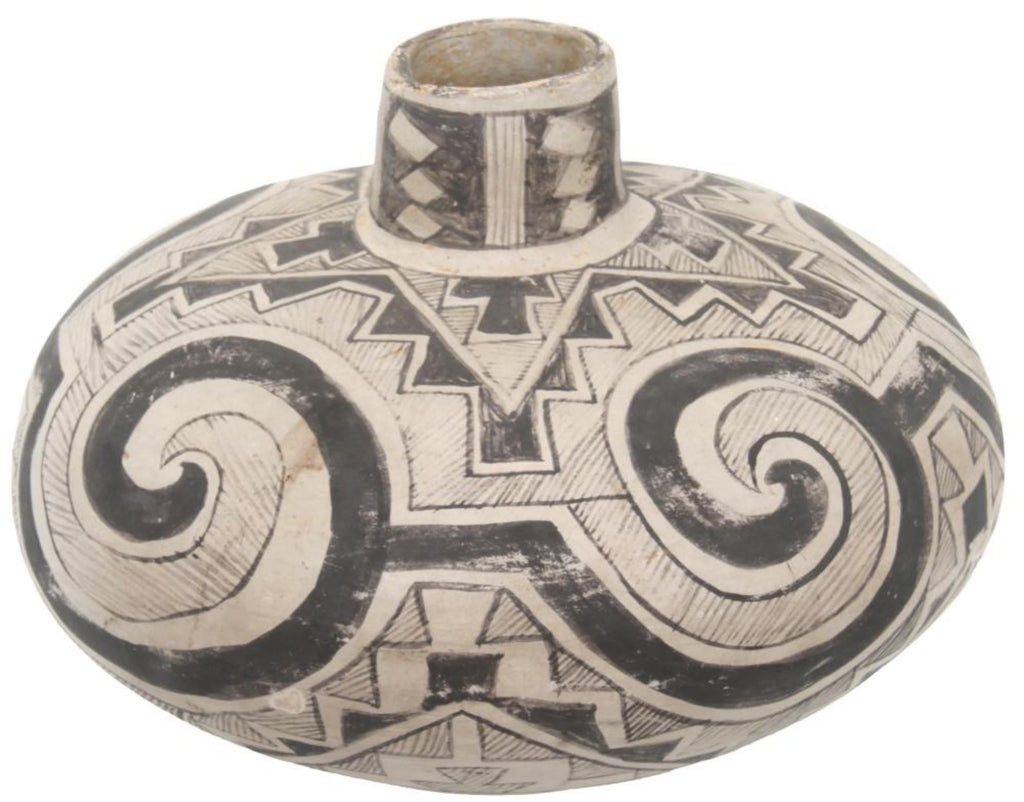
Ancestral Pueblo, Tularosa, Black-on-White Pottery Olla, Ca 1150-1300 CE, #1661 SOLD
$ 2,250.00
Description: #1661 Ancestral Pueblo Tularosa, Black-on-White Pottery Olla, Ca 1150-1300 CE. black geometric and scrolling designs against a cream-colored background, bulbous form with cylindrical neck.
Dimensions: 8 in. high x 10 1/2 in. diameter
Condition: As found, very good for its age.
Culture: Ancestral Pueblo: Southern Colorado Plateau (Anasazi)
Branch: Central Anasazi
Tradition: Chaco and Cibola
Ware: Chaco-Cibola White Ware
First posted by C. Dean Wilson 2012
"Tularosa Black-on-white was defined by Gladwin and Gladwin (1931). This type is similar to Reserve Black-on-white, but exhibits later painted styles and manipulations (Hays-Gilipin 1998; McGimsey 1980; Nesbittt 1938; Rinaldo and Bluhm 1956; Wilson 1999). Surfaces tend to be slipped, well-polished, and lustrous. Tularosa Black-on-white appears to have been produced from about 1150 to 1300 and is commonly associated with large late villages in the Southern Cibola Anasazi and Northern Mogollon regions".
"Pottery assigned to Tularosa Black-on-white tends to be very distinct from types produced in other Southwest regions. It is contemporary to but very distinct from Mesa Verde Black-on-white, and provinces dominated by these two types tend to be sharply separated with few areas where significant frequencies of the two types occur together. Designs and layout are similar to those noted on St. John Black-on-red. Slipped surfaces are often pearly white and tend to exhibit a crackled finish. Vessel walls tend to be thick. Temper almost always consists of sherd and sand may be present, but is often absent. Ollas and narrow necked jars are the most common vessel form although bowls lades, and effigy forms are consistently present. Paint consists of a thickly applied mineral pigment and is usually black but may be brown".
"Design motifs consist of combinations of curvilinear and rectilinear opposed hatched and solid bands. As compared to earlier Reserve Black-on-white, designs elements tend to be small and precisely executed. Elements are often tightly packed and busy with much less negative space than earlier types. Elements include pendants, triangles step triangles and barbed lines. Other designs include interlocking hachure and solids with rectilinear patterns more common than curvilinear. Solid spaced elements tend to be smaller than the opposing hatched elements. Hatching tends to be diagonal across framing lines although oblique and longitudinal hatching does occur and is sometimes combined into a single element. Hatched lines are usually thin more closely spaced, and line work appears to be finer than that in earlier Cibola White Ware types. Hatched portions tend to be smaller in size than other Cibola White Ware types and are more equally balanced in proportion to the solid elements. When hatching meets at corners, lines often cross to form small square or diamond shapes. Painted designs tend to cover much more of the total vessel surfaces than earlier types, often creating striking effects".
References:
Gladwin, Winifred and Harold S. Gladwin
1931 Some Southwestern Pottery Types, Series II. Medallion Papers 10, Gila Pueblo, Globe, Arizona.
Hays-Gilpin, Kelley., and Eric van Hartesveldt
1998 Prehistoric Ceramics of the Puerco Valley: The 1995 Chambers-Sanders Trust Lands Ceramic Conference. Museum of Northern Arizona Ceramic Series No.7. The Museum of Northern Arizona, Flagstaff.
McGimsey, Charles R. III
1980 Mariana Mesa: Seven Prehistoric Settlements in West-Central New Mexico. Papers of the Peabody Museum of Archaeology and Ethnology, Harvard University, Press, Cambridge.
Nesbitt, Paul
1938 Starkweather Ruin. Logan Museum Publications in Anthropology, Bulletin 6, Beloit College, Beloit, Wisconsin.
Rinaldo, John B., and Elaine Bluhm
1956 Late Mogollon Pottery Types of the Reserve Area. Fieldiana: Anthropology 36 (7):149-187.
Wilson, C. Dean
1999 Ceramic Types and Attributes. In Archaeology of the Mogollon Highlands Settlement Systems and Adaptations; Volume 4. Ceramics, Miscellaneous Artifacts, Bioarchaeology. Bone Tools and Faunal Analysis, edited by Y.R Oakes and D.A. Zamora, pp. 5-86. Office of Archaeological Studies Archaeology Notes 232, Museum of New Mexico, Santa Fe.
Dimensions: 8 in. high x 10 1/2 in. diameter
Condition: As found, very good for its age.
Culture: Ancestral Pueblo: Southern Colorado Plateau (Anasazi)
Branch: Central Anasazi
Tradition: Chaco and Cibola
Ware: Chaco-Cibola White Ware
First posted by C. Dean Wilson 2012
"Tularosa Black-on-white was defined by Gladwin and Gladwin (1931). This type is similar to Reserve Black-on-white, but exhibits later painted styles and manipulations (Hays-Gilipin 1998; McGimsey 1980; Nesbittt 1938; Rinaldo and Bluhm 1956; Wilson 1999). Surfaces tend to be slipped, well-polished, and lustrous. Tularosa Black-on-white appears to have been produced from about 1150 to 1300 and is commonly associated with large late villages in the Southern Cibola Anasazi and Northern Mogollon regions".
"Pottery assigned to Tularosa Black-on-white tends to be very distinct from types produced in other Southwest regions. It is contemporary to but very distinct from Mesa Verde Black-on-white, and provinces dominated by these two types tend to be sharply separated with few areas where significant frequencies of the two types occur together. Designs and layout are similar to those noted on St. John Black-on-red. Slipped surfaces are often pearly white and tend to exhibit a crackled finish. Vessel walls tend to be thick. Temper almost always consists of sherd and sand may be present, but is often absent. Ollas and narrow necked jars are the most common vessel form although bowls lades, and effigy forms are consistently present. Paint consists of a thickly applied mineral pigment and is usually black but may be brown".
"Design motifs consist of combinations of curvilinear and rectilinear opposed hatched and solid bands. As compared to earlier Reserve Black-on-white, designs elements tend to be small and precisely executed. Elements are often tightly packed and busy with much less negative space than earlier types. Elements include pendants, triangles step triangles and barbed lines. Other designs include interlocking hachure and solids with rectilinear patterns more common than curvilinear. Solid spaced elements tend to be smaller than the opposing hatched elements. Hatching tends to be diagonal across framing lines although oblique and longitudinal hatching does occur and is sometimes combined into a single element. Hatched lines are usually thin more closely spaced, and line work appears to be finer than that in earlier Cibola White Ware types. Hatched portions tend to be smaller in size than other Cibola White Ware types and are more equally balanced in proportion to the solid elements. When hatching meets at corners, lines often cross to form small square or diamond shapes. Painted designs tend to cover much more of the total vessel surfaces than earlier types, often creating striking effects".
References:
Gladwin, Winifred and Harold S. Gladwin
1931 Some Southwestern Pottery Types, Series II. Medallion Papers 10, Gila Pueblo, Globe, Arizona.
Hays-Gilpin, Kelley., and Eric van Hartesveldt
1998 Prehistoric Ceramics of the Puerco Valley: The 1995 Chambers-Sanders Trust Lands Ceramic Conference. Museum of Northern Arizona Ceramic Series No.7. The Museum of Northern Arizona, Flagstaff.
McGimsey, Charles R. III
1980 Mariana Mesa: Seven Prehistoric Settlements in West-Central New Mexico. Papers of the Peabody Museum of Archaeology and Ethnology, Harvard University, Press, Cambridge.
Nesbitt, Paul
1938 Starkweather Ruin. Logan Museum Publications in Anthropology, Bulletin 6, Beloit College, Beloit, Wisconsin.
Rinaldo, John B., and Elaine Bluhm
1956 Late Mogollon Pottery Types of the Reserve Area. Fieldiana: Anthropology 36 (7):149-187.
Wilson, C. Dean
1999 Ceramic Types and Attributes. In Archaeology of the Mogollon Highlands Settlement Systems and Adaptations; Volume 4. Ceramics, Miscellaneous Artifacts, Bioarchaeology. Bone Tools and Faunal Analysis, edited by Y.R Oakes and D.A. Zamora, pp. 5-86. Office of Archaeological Studies Archaeology Notes 232, Museum of New Mexico, Santa Fe.
Related Products
Sold out
Sold out






